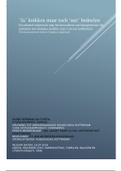Scriptie
Scriptie, Analyse Complexe Zorg Situatie
- Vak
- Afstuderen
- Instelling
- Hogeschool Rotterdam (HR)
Hoi, dit is mijn scriptie die ik in het jaar 2018/2019 geschreven heb. Ik heb mijn scriptie binnen 1 kans gehaald. Geschreven aan de hand van de eisen en studiehandleiding type: Analyse Complexe zorgsituatie. Onderwerp: Therapietrouw bevorderen bij patiënten met een taalbarriére. Deze scriptie is...
[Meer zien]




